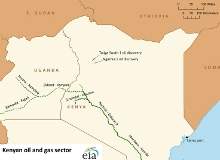

The Kenya-Uganda oil pipeline project is being jointly developed by the Kenyan and Ugandan governments. It will replace road tankers as the primary means for transporting oil products from Kenya to Uganda.
The new pipeline will connect Eldoret in Kenya to Kampala in Uganda, passing through Malaba. It will deliver white petroleum products from Kenya to Uganda and vice-versa.
The governments of Kenya and Uganda together hold a 49% (24.5% each) share in the pipeline project, while private investors will have a 51% stake. The private investors are yet to be confirmed for the project.
Route of the crude pipeline between Kenya and Uganda
The new pipeline will be 352km long and will interconnect the existing 14-inch-diameter pipeline that runs from Nairobi to Eldoret. It also includes the addition of a spur line to Jinja in Uganda and construction of a common user depot at the pipeline terminal in Kampala.
Kenya-Uganda crude oil pipeline project background
The crude oil pipeline is being developed through a public-private partnership under a 20-year build, own, operate and transfer arrangement between Uganda and Kenya in 1995. The partnership will be handled and operated by a joint coordinating commission (JCC).
The contract for conducting feasibility studies for the construction of the pipeline was awarded to an international firm in 1997. The study was completed in 1998 and the report submitted the next year. The study was funded by The European Investment Bank (EIB). It reported that the pipeline project would be feasible to build.
Tamoil initially received a contract to build the pipeline in 2007, but the contract was later cancelled in 2012 as the company failed to implement the project.
Construction of the Kenya-Uganda pipeline
The Ugandan and Kenyan governments agreed to aim for construction of the pipeline to begin in June. The construction is expected to be completed within a timeframe of 27 to 32 months so that the pipeline is commissioned by 2016.
The JCC invited bids for construction of the pipeline in January and received bidding proposals from 14 companies. These included a consortium of the National Oil Corporation of Kenya and Indian Oil Corporation, a consortium of Punjloid Infrastructure and Inpex Construction of Japan, a consortium of Eiffage and Consolidated Contractors Group, Oil India and a consortium of Kalpataru Power Transmission and China Petroleum Pipeline Bureau.
Other companies that bidded for the project were Turner & Townsend, Mota-Engil, Engenharia e Construção of Portugal, Oasis Consortium Group Denys of Belgium, Alfaraa Jihind Consortium, Vitol of France, the National Gas Company of Trinidad and Tobago and Orascom Construction Industries of Egypt.
Kenya-Uganda pipeline terminal details
The pipeline will use a common user depot, expected to be located to the east of Kampala. The terminal will have a capacity of 72,000m3 and will transport products to and from Kampala and Eldoret.
The terminal will include construction of two tanks with a capacity of 32,500m3 for MPS products, two tanks with a capacity of 5,654m3 for BIK products, two tanks with a capacity of 10,544m3 for JET products, and two more tanks with 22,570m3 capacity for AGO products. It will also include construction of four interface tanks with a capacity of 904m3.
Future extension plans for Kenya-Uganda pipeline
The oil pipeline will extend to Kigali in Rwanda and Bujumbura in Burundian in the future. The feasibility study for the pipeline extension was awarded to East African Community (EAC) in September 2011. The study was funded with $600,000 by the African Development Bank (ADB).
The pipeline extension was accepted in principle by the Kenyan, Ugandan and Rwandan goverments.
Related content
Melut Basin Oil Project, Sudan
The Melut Basin in the Sudan is shaping up to be one of the major sources of crude oil in Africa.
Angola LNG Project, Soyo, Angola
The long-anticipated Angola LNG project is an integrated gas utilisation scheme comprising offshore and onshore operations.




